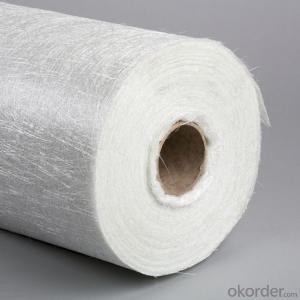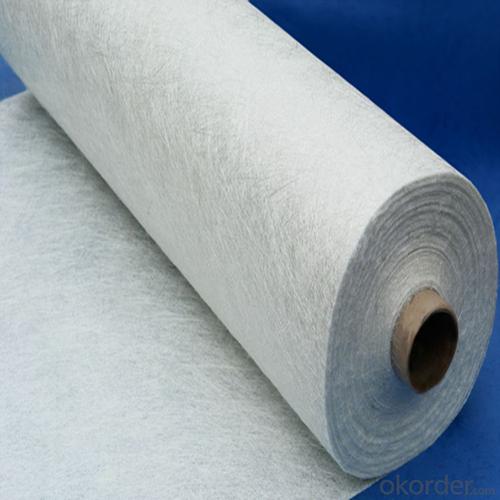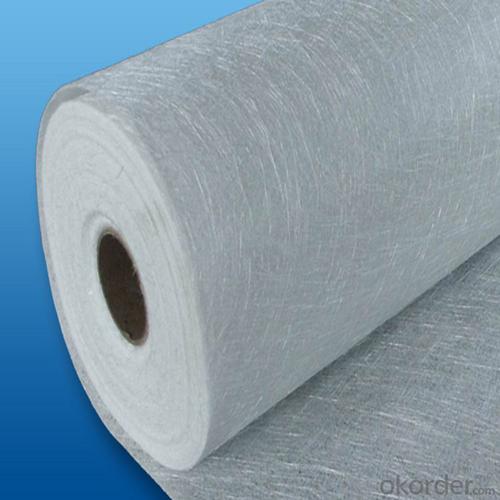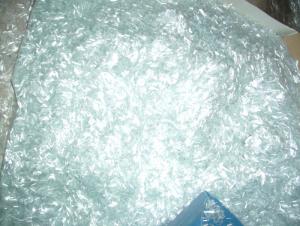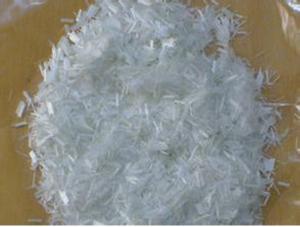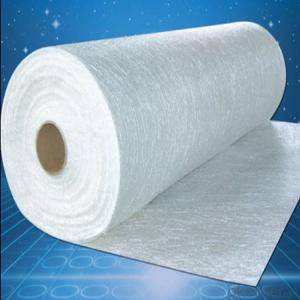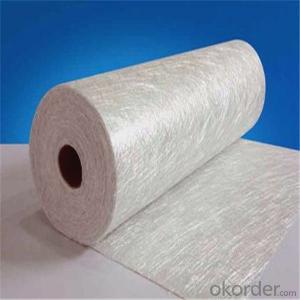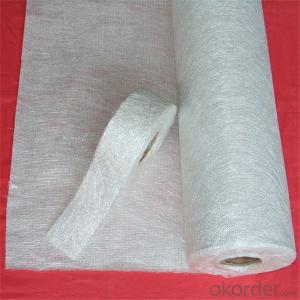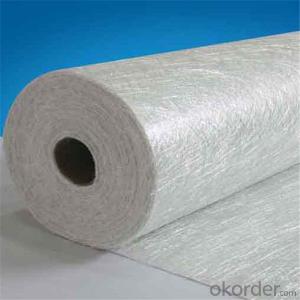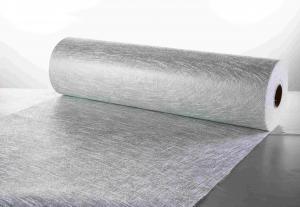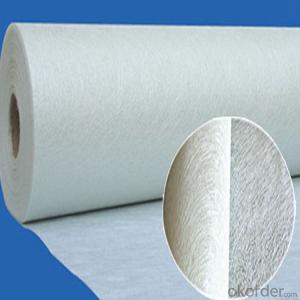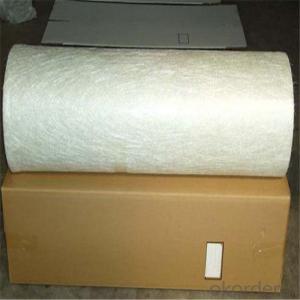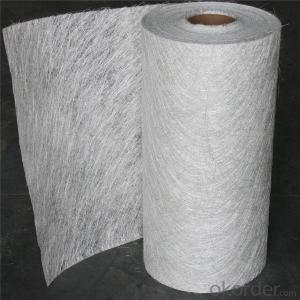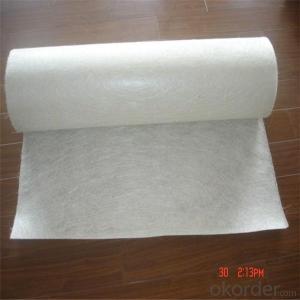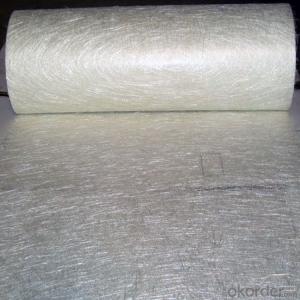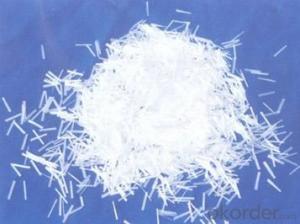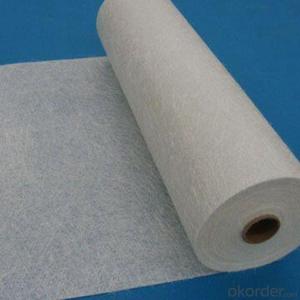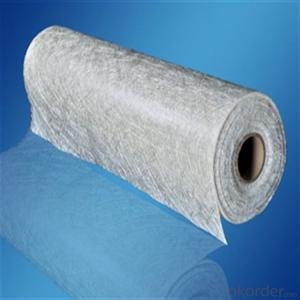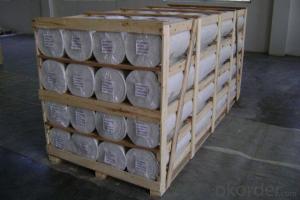Fiberglass Chop Strand Mat E-Glass Fiberglass Chopped Strand Mat
- Loading Port:
- China main port
- Payment Terms:
- TT OR LC
- Min Order Qty:
- 1 kg
- Supply Capability:
- 5000 kg/month
OKorder Service Pledge
OKorder Financial Service
You Might Also Like
Specification
Product Description:
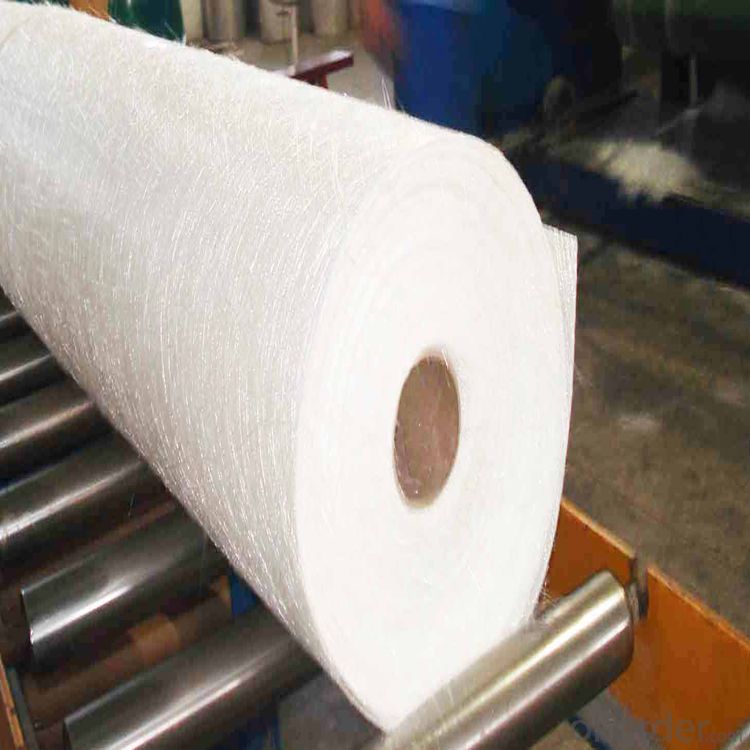
Surfacing Tissue mainly used in the surface layers of FRP products. It features even Fiber distribution, soft feel, level and smooth fiber surface, less glue content, quick resin soak and good pattern fitness. It can improve the product surface property on corrosion resistance, compressive strength, seepage resistance, and longer service life. It is also suitable for spraying; pattern pressing and other FRP pattern technology.
Surfacing Tissue mainly used in the surface layers of FRP products. It features even Fiber distribution, soft feel, level and smooth fiber surface, less glue content, quick resin soak and good pattern fitness. It can improve the product surface property on corrosion resistance, compressive strength, seepage resistance, and longer service life. It is also suitable for spraying; pattern pressing and other FRP pattern technology.
Product Features:
Fast breakdown in styrene
Fiber dispersed evenly
Low binder content
Superior acid corrosion resistance
Specifications:
Item | Over Density | Moisture Content | Chop Density | Polyester Yarn | Width |
(g/m2) | (%) | (g/m2) | (g/m2) | (mm) | |
EMK300 | 309.5 | ≤0.15 | 300 | 9.5 | 50-3300 |
EMK380 | 399 | 380 | 19 | ||
EMK450 | 459.5 | 450 | 9.5 | ||
EMK450 | 469 | 450 | 19 | ||
EMC0020 | 620.9 | 601.9 | 19 | ||
EMC0030 | 909.5 | 900 | 9.5 |
Product Packaging:
Each Surface Tissue is wound onto a paper tube which has an inside diameter of 76mm and the mat roll has a diameter of 330mm. The mat roll is wrapped up with plastic film,and then packed in a cardboard box or wrapped up with kraft paper. The rolls can be vertically or horizontally placed. For transportation, the rolls can be loaded into a cantainer directly or on pallets.
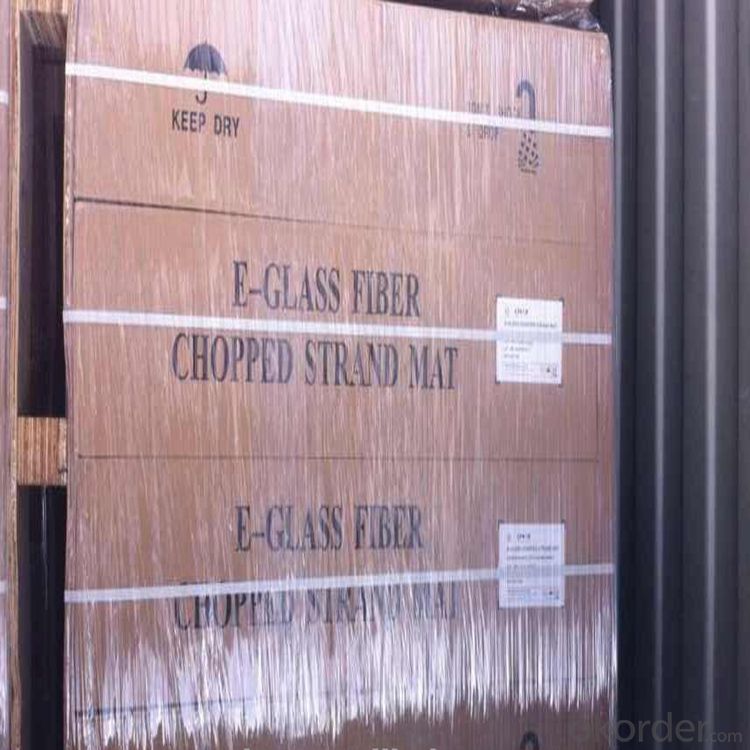
Product Storage:
Unless otherwise specified, Chopped Strand Mat should be stored in a dry, cool and rain-proof area. It is recommended that the room temperature and humidity should be always maintained at 15℃~35℃ and 50%~75% respectively.
Company Information
CNBM (China National Building Material) Group is the largest comprehensive building materials group in China that in integrate scientific research, manufacturing and logistics into one entity. The largest building materials and equipment specialists in China. Upon State Council approval, today CNBM owned more than 300 subordinate manufacturing factories and servicing companies. There are 6 fully owned public listed companies and 11 partially owned with substantial shares public listed companies. In many of these fields, CNBM is playing the leading role in the building industry in the country.
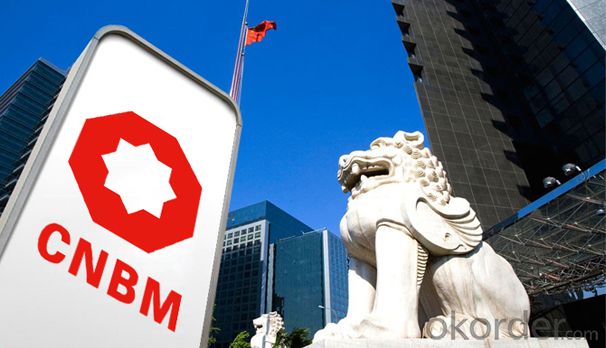
- Q: What are the alternatives to fiberglass chopped strand for reinforcing composites?
- There are several alternatives to fiberglass chopped strand for reinforcing composites, each with its own unique characteristics and advantages. Some of the commonly used alternatives include: 1. Carbon fiber: Carbon fiber is known for its high strength-to-weight ratio and excellent mechanical properties. It is often used in high-performance applications where lightweight and high strength are crucial, such as aerospace and automotive industries. However, carbon fiber is generally more expensive than fiberglass. 2. Aramid fiber (e.g., Kevlar): Aramid fibers are lightweight and possess excellent impact resistance and tensile strength. They are commonly used in applications where high impact resistance is required, such as bullet-proof vests, sporting equipment, and aerospace components. Aramid fibers are more expensive than fiberglass but offer superior performance in certain applications. 3. Basalt fiber: Basalt fibers are derived from volcanic rock and are known for their exceptional thermal and chemical resistance. They have similar mechanical properties to fiberglass but are more environmentally friendly and can withstand higher temperatures. Basalt fibers are often used in applications where fire resistance and thermal stability are essential, such as aerospace, automotive, and construction industries. 4. Natural fibers (e.g., flax, hemp, jute): Natural fibers are renewable, biodegradable, and often cheaper than synthetic alternatives. They offer good mechanical properties, low density, and are suitable for non-structural applications such as automotive interiors, furniture, and packaging. However, natural fibers may have limitations in terms of moisture absorption and long-term durability compared to synthetic options. 5. Glass fiber: Although fiberglass is the most commonly used reinforcement for composites, it is worth mentioning as an alternative to itself. Glass fibers offer good mechanical properties, chemical resistance, and are relatively inexpensive. They are widely used in various industries, including construction, automotive, marine, and consumer products. It is important to evaluate the specific requirements of the application, such as strength, weight, cost, environmental impact, and durability, when considering alternatives to fiberglass chopped strand for reinforcing composites. Each alternative has its own strengths and limitations, making it necessary to select the most appropriate option for the desired application.
- Q: What are the flexural modulus properties of fiberglass chopped strand?
- The ability of fiberglass chopped strand to resist deformation when bent or flexed is referred to as its flexural modulus properties. Fiberglass chopped strand is renowned for its impressive flexural modulus, indicating that it can withstand bending forces and maintain its shape when under stress. This particular attribute is a result of the reinforcing fibers present in the fiberglass, which provide the material with strength and rigidity. The flexural modulus of fiberglass chopped strand can vary based on various factors, including the length and orientation of the fibers, the type of resin matrix employed, and the manufacturing process. Nevertheless, fiberglass chopped strand generally exhibits outstanding flexural modulus properties, making it a favored option for applications requiring structural strength and stiffness.
- Q: What are the shear strength properties of fiberglass chopped strand?
- The shear strength properties of fiberglass chopped strand are affected by various factors, including the length and alignment of the strands, the resin matrix used, and the manufacturing process. In general, fiberglass chopped strand demonstrates good shear strength due to the interlocking nature of the randomly-oriented strands. The length of the chopped strands has a significant impact on shear strength. Longer strands tend to offer higher shear strength as they can distribute the applied load over a larger area. However, shorter strands may be preferred for specific applications where improved flow and easier processing are desired. The alignment of the chopped strands also influences shear strength. Randomly-oriented strands provide better interlocking and resistance to shear forces compared to aligned or unidirectional fibers. The random orientation enables the distribution of forces in multiple directions, enhancing the overall shear strength of the material. The resin matrix used in fiberglass chopped strand composites also plays a crucial role in determining shear strength properties. The resin should adhere well to the fibers and provide sufficient bonding strength to withstand shear loads. Epoxy resins, for example, are commonly used due to their excellent adhesion properties and high shear strength. The manufacturing process employed to produce fiberglass chopped strand can also impact shear strength properties. Factors such as compaction pressure, curing temperature, and post-processing techniques can influence the final shear strength of the material. Careful control of these parameters during manufacturing can optimize the shear strength properties of fiberglass chopped strand. In conclusion, fiberglass chopped strand demonstrates favorable shear strength properties due to the interlocking nature of the strands and the bonding strength provided by the resin matrix. However, it is important to consider the specific requirements of the application and select the appropriate fiber length, alignment, resin matrix, and manufacturing process to ensure optimal shear strength performance.
- Q: Can fiberglass chopped strand be used in water treatment applications?
- Indeed, water treatment applications can make use of fiberglass chopped strand. With its exceptional resistance to corrosion and chemicals, fiberglass proves to be a versatile material perfectly suited for water treatment procedures. Employing chopped strands of fiberglass allows for the reinforcement of multiple components, including pipes, tanks, and filters, which are essential in water treatment systems. The remarkable strength and durability of fiberglass render it highly capable of enduring the challenging conditions commonly encountered in water treatment facilities. Furthermore, fiberglass is non-toxic and does not release any detrimental substances into the water, guaranteeing the safety of the treated water supply.
- Q: What are the typical health and safety considerations when working with fiberglass chopped strand?
- When handling fiberglass chopped strand, it is important to keep in mind several health and safety factors: 1. Personal Protective Equipment (PPE): It is essential to wear suitable PPE when working with fiberglass chopped strand. This may include a respirator or dust mask to protect against breathing in airborne particles, safety glasses or goggles to prevent eye irritation or injury, and gloves to safeguard the hands from potential skin irritation or cuts. 2. Ventilation: Sufficient ventilation is crucial when dealing with fiberglass chopped strand. This helps reduce the inhalation of airborne particles and decrease the concentration of potentially harmful fumes or dust in the work area. If working indoors, ensure the area has good ventilation, and if possible, use exhaust fans or other ventilation systems to remove airborne contaminants. 3. Handling and storage: Fiberglass chopped strand can have sharp edges, so it is important to handle it carefully to avoid cuts or punctures. Proper storage of the material is also crucial to prevent accidental exposure or damage. Store the fiberglass chopped strand in a dry and secure location, away from heat sources or open flames. 4. Dust control: Fiberglass chopped strand can generate fine particles or dust during handling, cutting, or sanding. To minimize exposure to these particles, it is important to implement effective dust control measures. This may involve using wet methods, such as wet cutting or wet sanding, to reduce the generation of airborne dust. Additionally, using vacuum systems or dust collectors can help capture and contain any dust that is generated. 5. Training and awareness: Proper training and awareness are crucial when working with fiberglass chopped strand. All individuals working with this material should receive education on the potential hazards, proper handling techniques, and emergency response procedures. It is important to follow all safety guidelines and protocols to minimize the risk of injury or exposure to harmful substances. By considering these health and safety factors, individuals can ensure a safer working environment when dealing with fiberglass chopped strand. It is always advisable to consult safety guidelines and regulations specific to your country or region to ensure compliance with local requirements.
- Q: Can fiberglass chopped strand be used in the aerospace industry to reduce weight?
- Yes, fiberglass chopped strand can be used in the aerospace industry to reduce weight. Fiberglass is known for its high strength-to-weight ratio, making it an ideal material for lightweight applications. By utilizing fiberglass chopped strand in aerospace components, the overall weight of the aircraft can be reduced, leading to improved fuel efficiency and increased payload capacity.
- Q: How does the strength of fiberglass chopped strand compare to other reinforcement materials?
- Fiberglass chopped strand possesses comparable strength to other reinforcement materials utilized across different industries. Its high tensile strength, which refers to its resistance against being pulled apart, is well-known. When incorporated into composite materials, it significantly enhances structural integrity and overall strength of the final product. Although the strength of fiberglass chopped strand may be slightly lower than reinforcement materials like carbon fiber or aramid (Kevlar), it is imperative to consider the specific application and desired properties when selecting a reinforcement material. One advantage of fiberglass chopped strand lies in its cost-effectiveness. It generally proves more economical than carbon fiber or aramid, making it a popular choice when high strength is required while keeping costs in mind. Furthermore, fiberglass chopped strand is renowned for its corrosion resistance, electrical insulation properties, and thermal stability. These qualities render it suitable for a vast array of applications, including automotive components, construction materials, the marine industry, aerospace, and sports equipment. To conclude, although the strength of fiberglass chopped strand may slightly lag behind certain reinforcement materials, its cost-effectiveness, corrosion resistance, and other advantageous properties establish it as a dependable and extensively utilized option across various industries.
- Q: Can fiberglass chopped strand be recycled?
- Yes, fiberglass chopped strand can be recycled. It can be processed and used in various applications such as the production of new fiberglass products or as a filler material in composite materials. Recycling fiberglass chopped strand helps to reduce waste and conserve resources.
- Q: Is fiberglass chopped strand suitable for automotive interior panels?
- Yes, fiberglass chopped strand is suitable for automotive interior panels. Fiberglass chopped strand consists of short strands of glass fibers that are randomly dispersed and bonded together. This material is lightweight, strong, and has excellent dimensional stability, making it an ideal choice for automotive interior panels. It provides excellent strength-to-weight ratio, which is crucial for ensuring the panels can withstand the rigors of daily use while minimizing the overall weight of the vehicle. Additionally, fiberglass chopped strand has good resistance to chemicals, heat, and impact, further enhancing its suitability for automotive applications. Its versatility allows for easy molding and shaping into complex panel designs, ensuring a perfect fit for the interior components of automobiles. Overall, fiberglass chopped strand is a reliable and durable material that meets the specific requirements of automotive interior panels.
- Q: Can fiberglass chopped strand be used in the production of sporting goods?
- Yes, fiberglass chopped strand can be used in the production of sporting goods. Fiberglass chopped strand is a versatile material that offers several benefits for the manufacturing of sporting goods. It is lightweight, strong, and has excellent tensile strength, making it ideal for applications that require durability and high performance. In sporting goods production, fiberglass chopped strand is commonly used in the construction of various components such as hockey sticks, tennis rackets, golf clubs, and bicycle frames. Its high strength-to-weight ratio allows for the creation of lightweight yet robust products, enhancing the performance of athletes. Fiberglass chopped strand is also resistant to corrosion, which is beneficial for sporting goods that are exposed to moisture or outdoor elements. Furthermore, fiberglass chopped strand can be easily molded into different shapes and sizes, allowing for the production of complex designs and custom-made sporting goods. Its flexibility and ability to bond well with different resins make it an ideal material for creating composite structures that are strong and durable. Overall, fiberglass chopped strand is a suitable material for the production of sporting goods due to its lightweight, strength, durability, corrosion resistance, and versatility in manufacturing processes.
Send your message to us
Fiberglass Chop Strand Mat E-Glass Fiberglass Chopped Strand Mat
- Loading Port:
- China main port
- Payment Terms:
- TT OR LC
- Min Order Qty:
- 1 kg
- Supply Capability:
- 5000 kg/month
OKorder Service Pledge
OKorder Financial Service
Similar products
Hot products
Hot Searches
Related keywords

